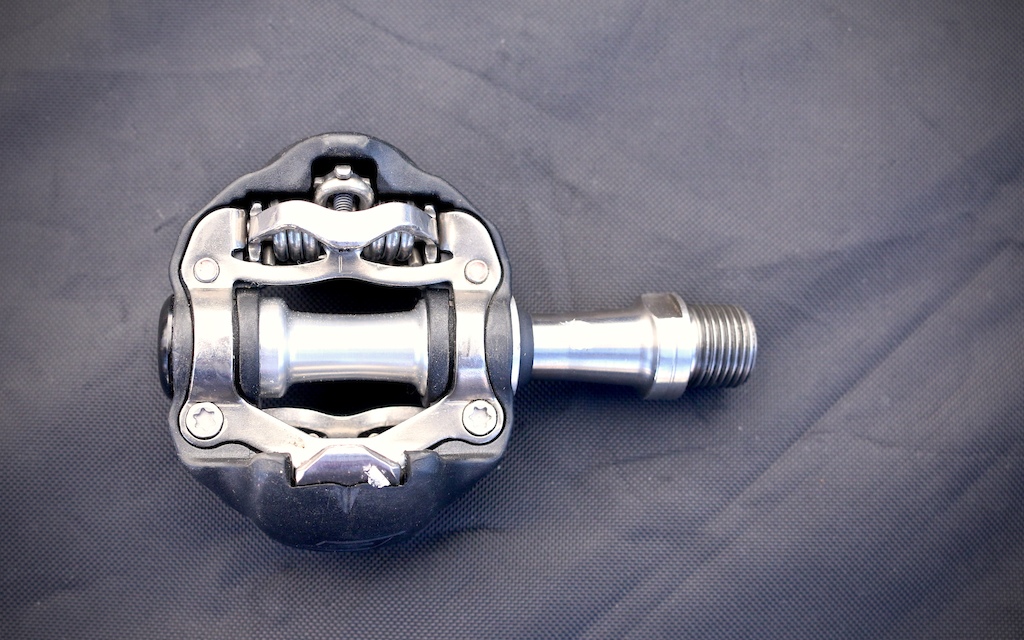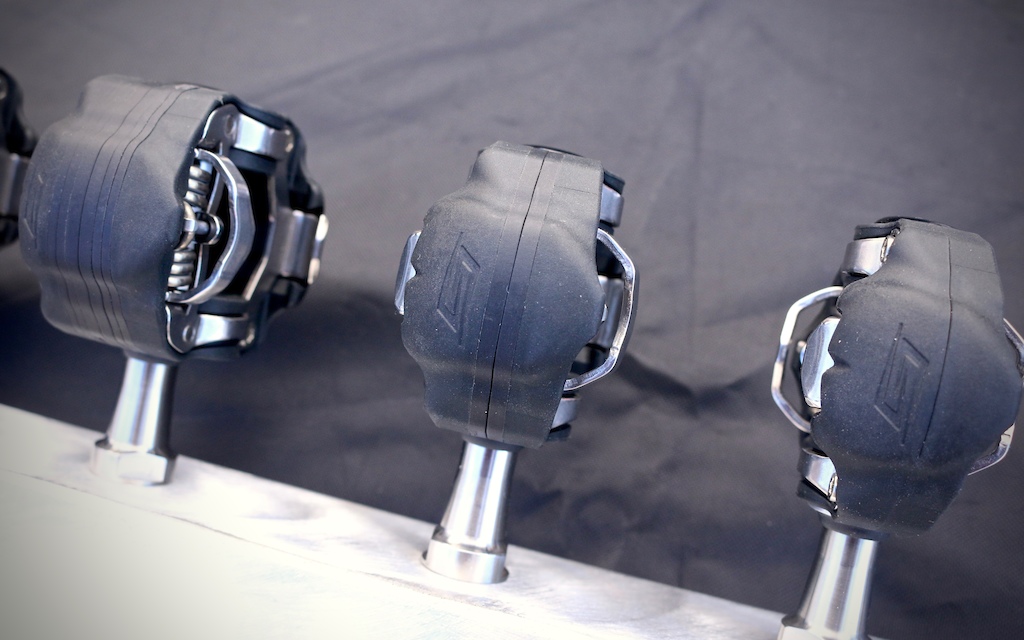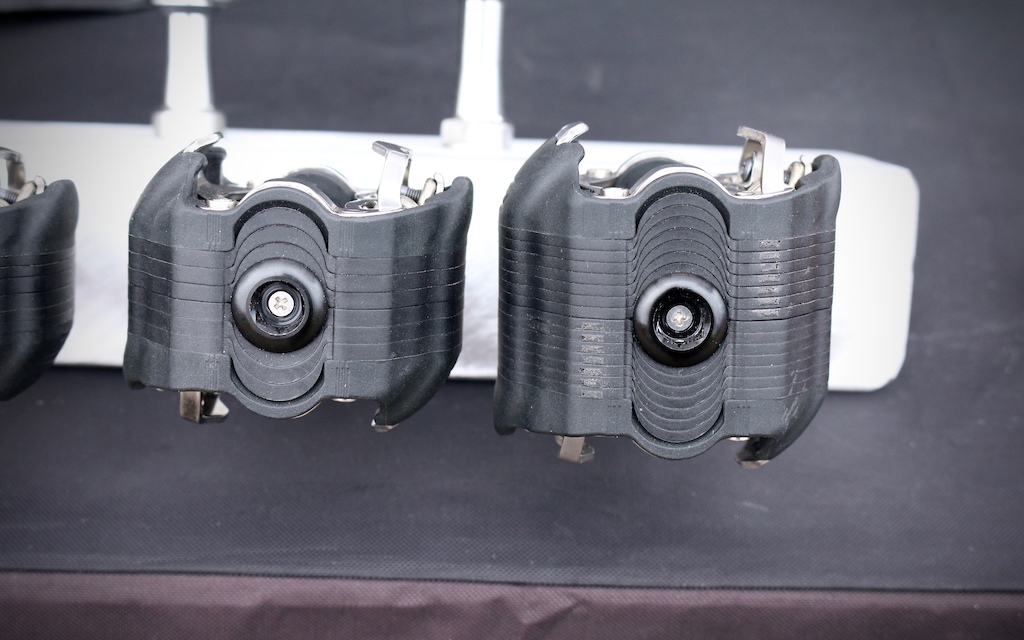Speedplay SYZR Pedal - Interbike 2016
Shimano and Crankbrothers are the first to come to most people's minds when thinking about clipless pedals, with companies like Time, HT, VP, and likely to a lesser extent, Speedplay; the latter not as prevalent as they once were when their Frog pedals were a more common sight. The SYZR pedal is their new-ish option designed for mountain biking, and while it's been around for awhile now, the company has updated the SYZR to offer an aftermarket stackable body, called the 'Leg Length Discrepancy Kit,' that allows riders to adjust pedal body height, and therefore how high your shoe sits above the spindle when you're clipped in.
SYZR Pedal Details
• Intended use: mountain biking
• Ceramic roller cam mechanism
• 10-degree, micro-adjustable float
• Composite body
• Adjustable pedal body height
• Weight: 275 grams (pair, titanium spindles)
• Intended use: mountain biking
• Ceramic roller cam mechanism
• 10-degree, micro-adjustable float
• Composite body
• Adjustable pedal body height
• Weight: 275 grams (pair, titanium spindles)
Speedplay's proprietary clip mechanism is screwed down onto the pedal's composite body, but should you want to raise that mechanism up, spacers can be installed in between the two halves of the LLDK pedal body kit. And since the clip mechanism is screwed down onto the body, it thereby raises it up and away from the pedal spindle. You can stack up a load of spacers if you wanted to - Speedplay had one pedal on display that was at least twice as thick as the stock setup - although I suspect that ground clearance would become a real issue at some point.
I bet I know what you're thinking: ''Why the hell would I want taller pedals?'' That's the same question that popped into my head mid-eye roll while I was standing in front of the Speedplay booth, but it could serve a purpose for some people. I'm friends with more than a few riders who, because of some sort of serious injury, have one leg that's significantly shorter than the other. Those who have real issues would usually wear some type of custom shoes in their day to day life that sport different sole heights, but it's not that easy when it comes to cycling kicks.
Or maybe it is if you were using the SYZR pedal.
Or maybe it is if you were using the SYZR pedal.
They employ an odd looking cleat that bolts to a standard two-hole SPD mount, and you adjust float via tiny screws that act as limit screws on the cleats themselves. The SYZR pedal is available in three flavors: with titanium spindles that weigh in at 275 grams for a pair; stainless steel spindles that weigh 312 grams for a pair; or the 338 gram chromoly spindle option.
Author Info:
Must Read This Week
Sign Up for the Pinkbike Newsletter - All the Biggest, Most Interesting Stories in your Inbox
PB Newsletter Signup








"I bet I know what you're thinking: ''Why the hell would I want taller pedals?'' That's the same question that popped into my head mid-eye roll while I was standing in front of the Speedplay booth, but it could serve a purpose for some people. I'm friends with more than a few riders who, because of some sort of serious injury, have one leg that's significantly shorter than the other."
-----
Leg length discrepancy (LLD) is actually more common (majority) in the general population than not. We are all asymmetrical to various degrees. The degree of LLD is important as small LLD may not require correction.
When walking or running the pelvis and feet are not fixed in space so can deal with asymmetry, if you observe wear patterns on your running sneakers you will see a telling clue to how you operate.
When on the bike you (asymmetrical) are fixed at foot and pedal, and bike is symmetrical - you often see effects of LLD on pelvic rotation and unstable pedalling stroke.
This difference can be structural or functional but is treated the same way in bike fitting on road bikes typically using 3-bolt pedal system with LLD shims between shoe and cleat, or varus wedges stacked in opposing group
However, this does not work as well in MTB as the common SPD system relies on contact between shoe and pedal - as you stack LLD shims the pedal loses contact with shoe and the SPD becomes unstable.
The old difficult method was stacking pontoons often requiring cutting and bonding to match the new cleat height.
This new SYZR looks like very smart thinking
cheers and happy trails!!
RC. Bikefit Pro bike fitter.
All of my seats have collapsed on the side with the shorter length, from my hips reaching down.
This product is super interesting.
They were not as good on downhills as DH riders and not as good on the uphills as XC riders"
youtu.be/hJdF8DJ70Dc
I have a 15mm discrepancy, for no particular reason.
For the last 3 years I kept having knee pain everytime I tried to ride a bit more regularly, until a physiotherapist found out the knee of the longer leg has a tendancy to stick outward a bit at every pedal cycle.
Since then I've been using 2 different pedals (xpedo flats, 11 et 20mm thick), but as I would have needed a 30mm pedal I also switched one of the crank so one is 175mm and the other 170mm, so while the difference is 10mm when the short leg is low and 0mm when it's high, the joint angles are similar.
The therapist said the torque difference shouldn't be a problem.
Since then most pain has disapeared and I've been able to ride regularly and much harder, also the pelvis is more stable and has much less tensions. Doing stretching regularly too.
In my case I "decided" it might be better if I could keep both of my legs' joints (hips, knees and ankles) work at a similar range of motion rather than go for a strict length correction, so I have asymetrical pedals and cranks, as a shorter crank + thicker pedal seem to draw a "better" trajectory than just a much thicker pedal (or a much shorter crank).
At 6 o'clock, when the leg stretches and the LLD is the bigger the left foot is 10mm higher than the right, but at 12 o'clock, when the calf is nigh horizontal and the LLD not that important, the shorter crank attenuates the thicker pedal. At 3 and 9 o'clock it's somewhere in between.
It doesn't work that well if I'm standing on the pedals though.
But so far it's working.
It's also different if the LLD is on the femora or tibia.
Yeah, that's like comparing Jesus to Satan (yes, in that order)
Sooo, for 95% of mtn. bikers, has anybody come up with anything approaching the quality and value of Shimano's spd's in the past 25 years? No? OK, thanks for showing up. Buh Bye.